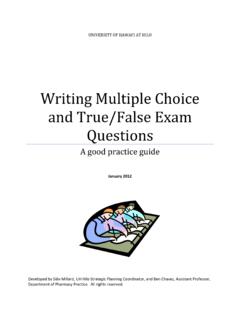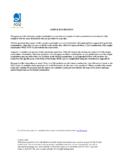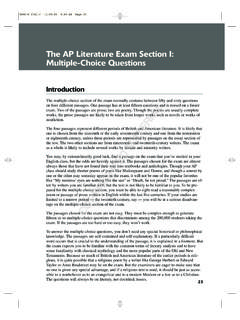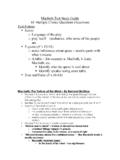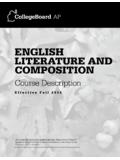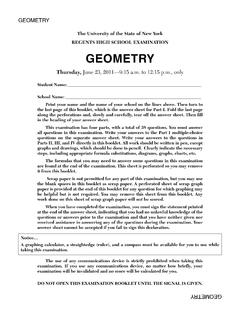Transcription of AP Govt. Multiple Choice question bank - eastwood4.com
1 AP Government Multiple Choice questions (From 2009 Course Description, 1989, 1999, 2002 released exams) I. Constitutional Underpinnings 1. In the organization of government, the principle of federalism is illustrated BEST by the a. President s power as commander in chief. b. Separation of powers between the US Supreme Court and the Congress. c. Representation system for electing senators. d. Qualifications for the office of President. e. Federal bureaucracy. 2. The Constitution and its amendments expressly prohibit all of the following EXCEPT a. Slavery. b. Double jeopardy. c. Cruel and unusual punishment. d. Unreasonable searches and seizures. e. Sex discrimination in employment. 3. All of the following were concerns about the Articles of Confederation that led to the calling of the Constitutional Convention of 1787 EXCEPT a.
2 Dissatisfaction over safeguards of individual rights and liberties. b. Fears for the stability of the central government. c. Desire to promote trade among the states. d. The need to give the central government the power to levy taxes. e. Dissatisfaction with the central government s ability to provide for the national defense. 4. In the United States, which of the following is a rule on voting found in the Constitution or its amendments? a. No person may be denied the right to vote merely for lack of either state or federal citizenship. b. No person 18 years of age or older may be denied the right to vote on account of age. c. No person may be denied the right to vote merely because he or she has previously served a prison sentence. d. A state may not establish a residency requirement for voting. e. A state may require a person to pay a poll tax in order to register to vote.
3 5. Which of the following is argued by James Madison in The Federalist paper number 10? a. A system of republican representation helps to limit the excesses of factionalism. b. Small republics are better able to ensure individual liberty than are large republics. c. The presence of a few large factions helps to protect the rights of minorities. d. Participatory democracy is the surest way to prevent tyranny. e. The elimination of the causes of factionalism the best protection against tyranny. 6. The Tenth Amendment to the Constitution has been interpreted by the Supreme Court to a. Prevent states from taxing agencies of the federal government. b. Reserve powers to the states. c. Restrict the application of judicial review. d. Allow for the burning of the flag as an expression of protest. e. Limit the use of the legislative veto.
4 7. The terms fiscal federalism and cooperative federalism refer to situations in which? a. The federal government completely dominates state and local governments. b. States are forbidden any activity that has not been specifically approved by the Supreme Court. c. The federal judiciary uses its power of judicial review to ensure congressional dominance over state legislatures. d. State, municipal, and local income taxes are pooled by special agreement and redistributed in accordance with individual need. e. Federal, state and local governments work together to complete a project, with the federal government providing much of the project funding. 8. Of the following, which has been used most to expand the power of the national government? a. The commerce clause of the Constitution b. The habeas corpus clause of the Constitution c.
5 The bill of attainder clause of the Constitution d. The First Amendment e. The Fifth Amendment 9. Following the Civil War the Fourteenth Amendment to the United States Constitution was designed to overturn the a. Dred Scott decision. b. Plessy v. Ferguson ruling. c. Emancipation Proclamation. d. Civil Rights Act of 1866. e. Slaughterhouse cases. 10. The procedure for formally amending the United States Constitution BEST illustrates which of the following? a. The dominance of the national government over state governments b. The dominance of the state governments over the national government c. The Founding Fathers desire to facilitate rapid constitutional revisions d. The Supreme Court s power to review constitutional amendments e. The federal structure of the United States government 11. Which of the following is one of the central concerns of the First Amendment?
6 A. The supremacy of the national over the state governments b. The right of citizens to bear arms c. The division of powers among the tree branches of government d. The right of citizens to petition the government for redress of grievances e. The protection of the rights of those accused of a crime. 12. The wall of separation doctrine refers to the a. Division between levels of government. b. Unique powers possessed by each branch of government. c. Division of church and state. d. Barrier between legislative chambers. e. Differentiation of municipal powers from county powers. 13. States and localities have the most discretion in establishing policy when federal funding is derived from a. Categorical grants b. Matching grants c. Block grants d. Project grants e. Grants- in- aid 14. Which of the following is true under the system of checks and balances?
7 A. The Supreme Court can overrule the President s policy proposals. b. The Senate must ratify realties negotiated by the President before they become law. c. A bill becomes law when the House and the Senate pass it, and the Supreme Court declares it constitutional. d. The Supreme Court can remove members of Congress, and Congress can impeach the President. e. The House of Representatives appoints justices to the Supreme Court and the Senate approves the appointments. 15. In The Federalist Number 10, James Madison argued that factions in a republic are a. A more serious threat if the republic is large. b. Natural but controllable by institutions. c. Not likely to occur if people are honest. d. Prevented by majority rule. e. Prevented by free elections. 16. Which of the following was the most important effect of replacing the Articles of Confederation with the Constitution of 1787?
8 A. The protection of free speech b. The guarantee of states rights c. The establishment of direct democracy d. The creation of a strong national government e. The establishment of judicial review 17. Which of the following is NOT a core value of United States political culture? a. Legal equality b. Political equality c. Economic equality d. Freedom of religion e. Freedom of speech 18. In Marbury v. Madison (1803), the Supreme Court assumed the power to a. Decide whether internal congressional procedures are constitutional. b. Advice Congress on the constitutionality of a proposed law. c. Regulate slavery. d. Decide on the constitutionality of a law or an executive action. e. Approve executive agreements. Questions 22- 23 refer to the following excerpt from a US Supreme Court decision. We are unanimously of opinion, that the law passed by the legislature of Maryland, imposing a tax on the bank of the United States, is unconstitutional and is a tax on the operation of an instrument employed by the government of the Union to carry its powers into execution.
9 Such a tax must be 19. This decision of the Supreme Court upheld the principle that a. The federal government and the state governments are equal. b. Congress has only those powers specifically enumerated in the Constitution. c. Congress has the power to make laws to carry out the constitutional duties. d. Taxation without representation is unconstitutional. e. The federal government alone my levy taxes. 20. Which of the following resulted from this Supreme Court decision? a. The power of the national government was strengthened. b. The power of the Supreme Court was weakened. c. The power of state governments to tax individual citizens was clearly limited. d. Congress was given the power to coin money. e. Congress alone was given the power to charter banks. 21. In the Constitution as originally ratified in 1788, the provisions regarding which of the following most closely approximate popular, marjoritarian democracy?
10 A. Election of members of the House of Representatives b. Election of members of the Senate c. Election of the President d. Ratification of treaties e. Confirmation of presidential appointments 22. Which of the following BEST defines the constitutional interpretation of federalism? a. The federal government and the states each have separate and mutually exclusive roles and responsibilities. b. The states have some powers reserved to them which they may exercise if the Supreme Court permits. c. The federal government and the states have separate but overlapping powers; where these powers conflict, the federal government prevails. d. The states may only exercise those powers delegated to them by Congress. e. The federal government may exercise only those powers specifically enumerated in the Constitution. 23. All of the following issues were decided at the Constitutional Convention EXCEPT a.
